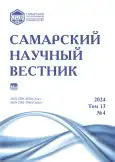Способы активизации речевой деятельности студентов-филологов на уроке иностранного языка путем сокращения объема и повышения эффективности речевой деятельности преподавателя
- Авторы: Аблякимова Ф.Г.1
-
Учреждения:
- Крымский инженерно-педагогический университет имени Февзи Якубова
- Выпуск: Том 13, № 4 (2024)
- Страницы: 97-102
- Раздел: Педагогические науки
- URL: https://bakhtiniada.ru/2309-4370/article/view/284637
- DOI: https://doi.org/10.55355/snv2024134301
- ID: 284637
Цитировать
Полный текст
Аннотация
В статье рассматривается непропорциональность речи преподавателя и студента на уроке иностранного языка в вузе. Это явление приводит к негативному эффекту, который отражается на объеме и качестве речевой деятельности студента на уроке. Экспериментальный прием наблюдения как со стороны самого преподавателя, так и со стороны коллеги-преподавателя позволяет установить объем и качество речевой деятельности преподавателя на уроке. С этой целью автором был проведен анализ девяти уроков трех преподавателей английского языка филологического факультета Крымского инженерно-педагогического университета имени Февзи Якубова, обучавших студентов по программе бакалавриата (45.03.01) направления подготовки «Филология» в 2023/2024 учебном году. Цель работы – определить способы повышения количества и качества речевой деятельности студента путем сокращения объема речевой деятельности преподавателя и использования эффективных методов, способствующих активизации речевой деятельности студента. Автор отмечает целесообразность повышения мотивации студентов к участию в речевом взаимодействии с помощью более систематической работы обучаемых в парах, группах, а также участия в дискуссиях, использования игр и выполнения проектов. Преподаватель достигнет большего успеха в активизации речевой деятельности студентов при использовании вопросов открытого типа, побуждающих к размышлению. Студенты будут выстраивать более продуманные, содержательные, развернутые ответы, если преподаватель будет выделять студенту большее количество времени на обдумывание ответа.
Полный текст
Открыть статью на сайте журналаОб авторах
Фаузия Гильмрахмановна Аблякимова
Крымский инженерно-педагогический университет имени Февзи Якубова
Автор, ответственный за переписку.
Email: afauziya@mail.ru
старший преподаватель кафедры английской филологии
РоссияСписок литературы
- Гладкая И.В., Гутник И.Ю. Педагогическая диагностика профессиональной подготовки будущих педагогов: учеб.-метод. пособие. СПб.: Изд-во РГПУ им. А.И. Герцена, 2022. 120 с.
- Дудина М.М., Хаматнуров Ф.Т. Основы психолого-педагогической диагностики: учеб. пособие. Екатеринбург: Изд-во Рос. гос. проф.-пед. ун-та, 2017. 189 с.
- Егорова У.Г. Педагогическая психодиагностика: учеб. пособие. Самара: Издательство Самарского университета, 2021. 88 с.
- Ингенкамп К. Педагогическая диагностика / пер. с нем. М.: Педагогика, 1991. 238 с.
- Симонов В.П. Педагогическая диагностика в школе и вузе: учеб. пособие. М., 2008. 208 с.
- Rabani Ebrahimipour K., Fatehi Rad N., Rayani E. The ratio of teacher talking time (TTT) to student talking time (STT) in Iranian EFL classes: an observational multi-class analysis [Internet] // Journal of Teaching English Language Studies. 2023. Vol. 8, iss. 3. https://sanad.iau.ir/Journal/tels/ Article/1120099.
- Kostadinovska-Stojchevska B., Popovikj I. Teacher talking time vs. student talking time: moving from teacher-centered classroom to learner-centered classroom // The International Journal of Applied Language Studies and Culture. 2019. Vol. 2, iss. 2. P. 25–31. doi: 10.34301/alsc.v2i2.22.
- Malik A.H., Jalall M.A., Abbasi S.A.R., Rashid A. Exploring the impact of excessive teacher talk time on participation and learning of English language learners // VFAST Transactions on Education and Social Sciences. 2023. Vol. 11, № 2. P. 46–55.
- Cardenas F.L. Teacher talking time vs. student talking time: fostering speaking in the EFL classroom: Seminario de tesis para optar al título de profesor en comunicacion en lengua inglesa y al grado de licenciado en educacion. Valdivia, 2013. 63 p.
- Kareema M.I.F. Increasing student talk time in the ESL classroom: an investigation of teacher talk time and student talk time // The fourth International Symposium of SEUSL. Oluvil, 2014. P. 233–238.
- Колесникова И.Л., Долгина О.А. Англо-русский терминологический справочник по методике преподавания иностранных языков. М.: Дрофа; Cambridge University Press, 2008. 431 с.
- Zare-Behtash E., Azarnia T. A case study of teacher talk time and student talk time in an Iranian language school // International Journal of English Language, Literature and Translation Studies. 2015. Vol. 2, iss. 3. P. 274–285.
- Воронцова Е.В., Гришина А.С., Кольцова С.В. Увеличение STT как способ повышения эффективности обучения английскому языку студентов многопрофильного вуза // Мир педагогики и психологии. 2019. № 9 (38). С. 12–17.
- Назарова Н.В. Увеличение времени говорения обучающихся (STT) как средство оптимизации обучения говорению // Focus on Language Education and Research. 2022. Т. 3, № 3. С. 50–57. doi: 10.35213/2686-7516-2022-3-3-50-57.
- Jayalath U.D.T.L. The effect of English as a second language (ESL) teacher talk in creating classroom interactions // Sri Lanka Journal of Social Sciences and Humanities. 2021. Vol. 1, iss. 2. P. 181–191. doi: 10.4038/sljssh.v1i2.49.
- Richards J.C. The context of language teaching. Cambridge: Cambridge University Press, 1985. 228 p.
- Жармухамбет М.Е., Калакова Г.К. Action Research как инструмент повышения профессиональной компетенции педагога исследование в действии как инструмент повышения профессиональной компетенции педагога // Экономика и социум. 2019. № 6(61). С. 361–365.
- Зеер Э.Ф. Психология профессионального образования: учебник. 2-е изд., испр. и доп. М.: Академия, 2013. 377 с.
- Dobson J.M. Effective techniques for English conversation groups. Rowley: Newbury House Publishers, 1974. 137 p.
- Alexander L.G. For and against. An oral practice book for advanced students of English. Longman Group Ltd, 1968. 66 p.
- Abliakimova F.G. Quotes analysis for developing learner critical thinking // Innovative Techniques in Teaching English: materials of the 9 th All-Crimean Teacher Development Conference with International Participation. Simferopol, 2022. P. 3–8.
- Hadfield J. Advanced communication games: A collection of games and activities for upper-intermediate and advanced students of English. Thomas Nelson and Sons Ltd, 1987. 130 p.
- Barjesteh H., Moghadam B.A. Teacher questions and questioning strategies revised: a case study in EFL classroom in Iran // Indian Journal of Fundamental and Applied Life Sciences. 2014. Vol. 4, iss. 2. P. 651–659.
- Abhakorn J. Asking effective referential questions in an EFL classroom // The European Conference on Language Learning. 2014. P. 201–214.
- Yaqubi B., Rokni M.P. Teachers’ limited wait-time practice and learners’ participation opportunities in EFL classroom interaction // Journal of English Language Teaching and Learning. 2013. Vol. 4, iss. 10. P. 127–161.
- Nunan D. Second Language Teaching and Learning. Heinle & Heinle Publishers, 1999. 330 p.
Дополнительные файлы






